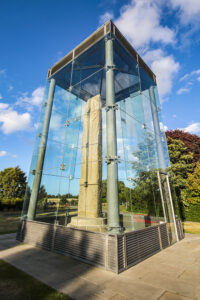Forres and the surrounding area is steeped in history, and perhaps the most mysterious is the hill fort on the top of Cluny Hill, indicating that people settled here thousands of years ago.
Sueno’s Stone

The town’s most notable ancient landmark is the monolithic Sueno’s Stone at the east end.
Carved with illustrious detail which has succumbed to the weather, thesingle slb is now encased on a glass shelter to protect it from the elements. At 21 feet, it is the tallest Pictish carved stone in the UK.
It probably dates from around 980AD. Many theories abound as to what the carved scene depicts but the most probable is that it shows a defeat of the men of Moray by Gaelicised Picts from the south.
The runes carved on the stone still mystify scholars today, one side is carved with a large ring-headed cross, the other side is divided into four panels depicting what appears to be a large but unknown battle scene which could possibly have been fought closeby.
Royal Burgh
Forres was confirmed as a Royal Burgh around the year 1496; it has been recorded that Forres had its own Royal Castle originally built in 900AD, possibly from the time of Kenneth McAlpine the first king of united Scotland.
After William I became King of Scotland in 1165, the castle at Forres served as a hunting lodge for royalty. Today the mound on which the castle was built is still there, but unfortunately over the years, the remains of the castle have all been removed.
Macbeth
The ancient royal burgh of Forres has links with King Macbeth. Before he became king of Scotland he fought Duncan near Pitgaveny where Duncan was killed on 10 August 1040. Macbeth was immediately crowned at Scone to legitimise his position and he ruled over Moray from his castle in Forres. Originally built at the west end of Forres high street the castle no longer remains but the area still bears the name ‘Castlehill’.
Falconer Museum

The Falconer Museum was built from a bequest by Alexander and Hugh Falconer to house a large collection of fossils. It was named after Hugh in the 19th century.
He was a distinguished geologist, botanist, palaeontologist and paleoanthropologist and spent much of his life studying the geology, plant and animal life of India, Assam and Burma.
The museum is currently closed due to funding cuts by Moray Council.
Click here to view The Falconer Museum website.

